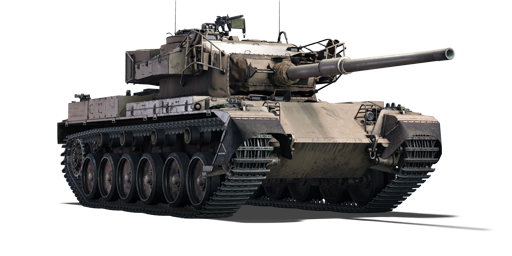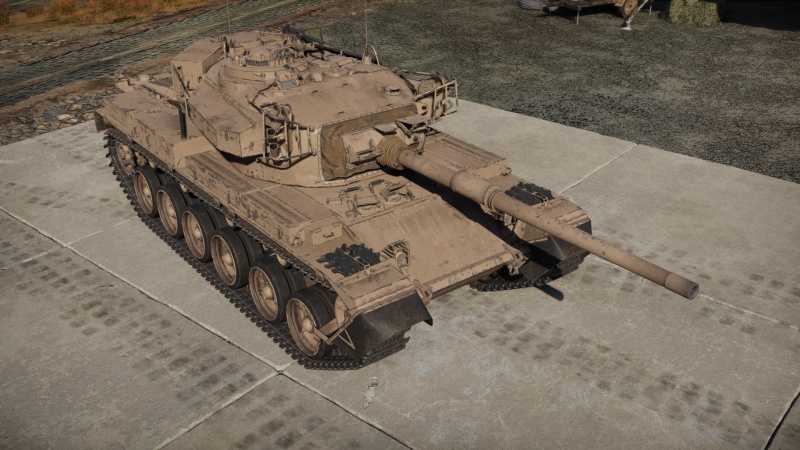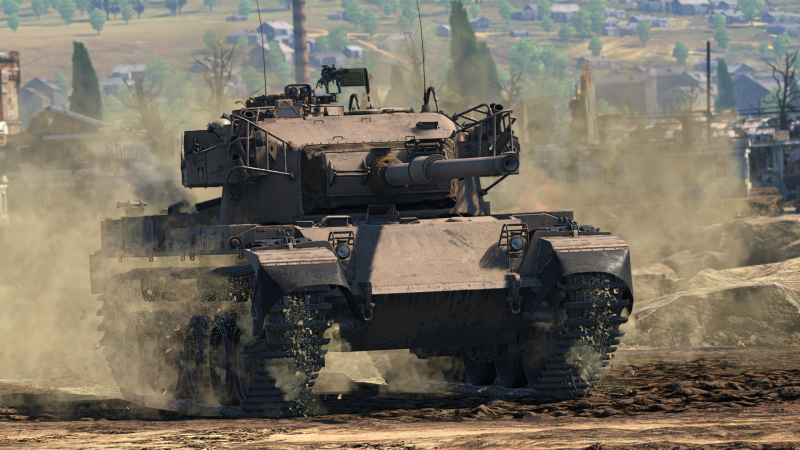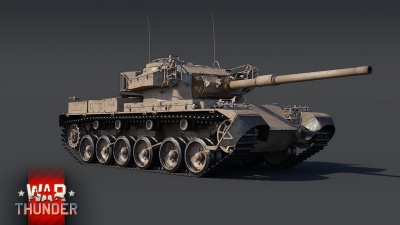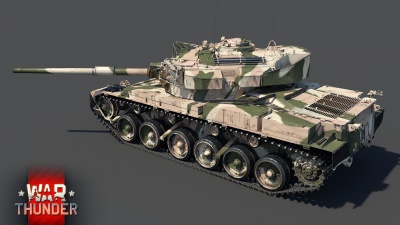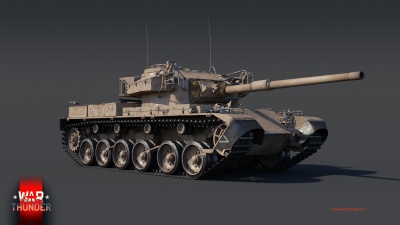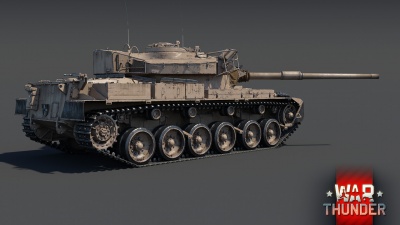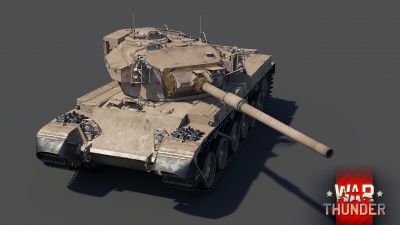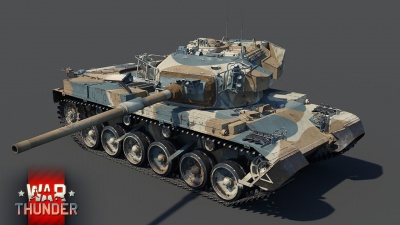Difference between revisions of "Olifant Mk.1A"
(Created page) |
m ('Radial' V12 is a nonsensical term, the AV1790 is a V-type engine) (Tag: Visual edit) |
||
| (33 intermediate revisions by 9 users not shown) | |||
| Line 1: | Line 1: | ||
| + | {{About | ||
| + | | about = British medium tank '''{{PAGENAME}}''' | ||
| + | | usage = the other version | ||
| + | | link = Olifant Mk.2 | ||
| + | }} | ||
{{Specs-Card | {{Specs-Card | ||
|code=uk_olifant_mk_1a | |code=uk_olifant_mk_1a | ||
| − | |images={{Specs-Card-Image|GarageImage_{{PAGENAME}}.jpg}} | + | |images={{Specs-Card-Image|GarageImage_{{PAGENAME}}.jpg|ArtImage_{{PAGENAME}}.png}} |
}} | }} | ||
| Line 7: | Line 12: | ||
<!-- ''In the description, the first part should be about the history of the creation and combat usage of the vehicle, as well as its key features. In the second part, tell the reader about the ground vehicle in the game. Insert a screenshot of the vehicle, so that if the novice player does not remember the vehicle by name, he will immediately understand what kind of vehicle the article is talking about.'' --> | <!-- ''In the description, the first part should be about the history of the creation and combat usage of the vehicle, as well as its key features. In the second part, tell the reader about the ground vehicle in the game. Insert a screenshot of the vehicle, so that if the novice player does not remember the vehicle by name, he will immediately understand what kind of vehicle the article is talking about.'' --> | ||
The '''{{Specs|name}}''' is a rank {{Specs|rank}} British medium tank {{Battle-rating}}. It was introduced in [[Update "Ixwa Strike"]]. | The '''{{Specs|name}}''' is a rank {{Specs|rank}} British medium tank {{Battle-rating}}. It was introduced in [[Update "Ixwa Strike"]]. | ||
| + | |||
| + | The Olifant is an early South African modification of the legendary Centurion tank. The vehicle received an increase in firepower and mobility from the earlier British series, to match the needs of extended cruising capabilities and long-distance skirmishes within the dusty and heated African environment. | ||
| + | |||
| + | Fitted with a GT-3 cannon, the Olifant should be as persuasive as most NATO counterparts, due to the GT-3 being a variant of the popular British-made Royal Ordnance L7 gun. On the weak side, the armour layout can be described as obsolete against HEAT and APFSDS, which are quite common at Olifant's rank. This lack of armour simultaneously with a somewhat slow turret traverse and below average top speed, commits the Olifant to use distance, uneven grounds and marksmanship skills to endure the battles. | ||
== General info == | == General info == | ||
| Line 36: | Line 45: | ||
{{Specs-Tank-Mobility}} | {{Specs-Tank-Mobility}} | ||
<!-- ''Write about the mobility of the ground vehicle. Estimate the specific power and manoeuvrability, as well as the maximum speed forwards and backwards.'' --> | <!-- ''Write about the mobility of the ground vehicle. Estimate the specific power and manoeuvrability, as well as the maximum speed forwards and backwards.'' --> | ||
| − | |||
| − | {{tankMobility}} | + | {{tankMobility|abMinHp=1,162|rbMinHp=663}} |
=== Modifications and economy === | === Modifications and economy === | ||
| Line 49: | Line 57: | ||
<!-- ''Give the reader information about the characteristics of the main gun. Assess its effectiveness in a battle based on the reloading speed, ballistics and the power of shells. Do not forget about the flexibility of the fire, that is how quickly the cannon can be aimed at the target, open fire on it and aim at another enemy. Add a link to the main article on the gun: <code><nowiki>{{main|Name of the weapon}}</nowiki></code>. Describe in general terms the ammunition available for the main gun. Give advice on how to use them and how to fill the ammunition storage.'' --> | <!-- ''Give the reader information about the characteristics of the main gun. Assess its effectiveness in a battle based on the reloading speed, ballistics and the power of shells. Do not forget about the flexibility of the fire, that is how quickly the cannon can be aimed at the target, open fire on it and aim at another enemy. Add a link to the main article on the gun: <code><nowiki>{{main|Name of the weapon}}</nowiki></code>. Describe in general terms the ammunition available for the main gun. Give advice on how to use them and how to fill the ammunition storage.'' --> | ||
{{main|GT-3 (105 mm)}} | {{main|GT-3 (105 mm)}} | ||
| − | |||
{| class="wikitable" style="text-align:center" width="100%" | {| class="wikitable" style="text-align:center" width="100%" | ||
| Line 60: | Line 67: | ||
|- | |- | ||
! ''Arcade'' | ! ''Arcade'' | ||
| − | | rowspan="2" | 72 || rowspan="2" | -10°/+20° || rowspan="2" | ±180° || rowspan="2" | Two-plane || | + | | rowspan="2" | 72 || rowspan="2" | -10°/+20° || rowspan="2" | ±180° || rowspan="2" | Two-plane || 17.1 || 23.7 || 28.8 || 31.9 || 33.9 || rowspan="2" | 8.71 || rowspan="2" | 7.70 || rowspan="2" | 7.10 || rowspan="2" | 6.70 |
|- | |- | ||
! ''Realistic'' | ! ''Realistic'' | ||
| − | | | + | | 10.7 || 12.6 || 15.3 || 16.9 || 18.0 |
|- | |- | ||
|} | |} | ||
==== Ammunition ==== | ==== Ammunition ==== | ||
| − | { | + | {{:GT-3 (105 mm)/Ammunition|M152, M416, M156, M111}} |
| − | |||
| − | |||
| − | |||
| − | |||
| − | |||
| − | | | ||
| − | |||
| − | |||
| − | |||
| − | |||
| − | |||
| − | |||
| − | |||
| − | |||
| − | |||
| − | |||
| − | |||
| − | |||
| − | |||
| − | |||
| − | |||
| − | |||
| − | |||
| − | |||
| − | |||
| − | |||
| − | |||
| − | |||
| − | |||
| − | |||
| − | |||
| − | |||
| − | |||
| − | |||
| − | |||
| − | |||
| − | |||
| − | |||
| − | |||
| − | |||
| − | |||
| − | |||
| − | |||
| − | |||
| − | |||
| − | |||
| − | |||
| − | |||
| − | |||
| − | |||
==== [[Ammo racks]] ==== | ==== [[Ammo racks]] ==== | ||
| − | + | [[File:Ammoracks_{{PAGENAME}}.png|right|thumb|x250px|[[Ammo racks]] of the {{PAGENAME}}]] | |
| − | <!-- '''Last updated:''' --> | + | <!-- '''Last updated: 2.9.0.56''' --> |
{| class="wikitable" style="text-align:center" | {| class="wikitable" style="text-align:center" | ||
|- | |- | ||
| Line 132: | Line 89: | ||
! 5th<br>rack empty | ! 5th<br>rack empty | ||
! 6th<br>rack empty | ! 6th<br>rack empty | ||
| + | ! 7th<br>rack empty | ||
| + | ! 8th<br>rack empty | ||
! Visual<br>discrepancy | ! Visual<br>discrepancy | ||
|- | |- | ||
| − | | '''72''' || | + | | '''72''' || 66 ''(+6)'' || 61 ''(+11)'' || 58 ''(+14)'' || 54 ''(+18)'' || 46 ''(+26)'' || 32 ''(+40)'' || 8 ''(+64)'' || 1 ''(+71)'' || No |
|- | |- | ||
|} | |} | ||
| + | '''Notes''': | ||
| + | |||
| + | * Shells are modeled individually and disappear after having been shot or loaded. | ||
| + | * Rack 8 is a first stage ammo rack. It totals 7 shells and gets filled first when loading up the tank. | ||
| + | * This rack is also emptied early: the rack depletion order at full capacity is: 8 - 1 - 2 - etc. until 7. | ||
| + | * Simply not firing when the gun is loaded will move ammo from racks 1 to 7 into rack 8. Firing will interrupt the restocking of the ready rack. | ||
=== Machine guns === | === Machine guns === | ||
{{Specs-Tank-Weapon|2}} | {{Specs-Tank-Weapon|2}} | ||
| + | {{Specs-Tank-Weapon|3}} | ||
<!-- ''Offensive and anti-aircraft machine guns not only allow you to fight some aircraft but also are effective against lightly armoured vehicles. Evaluate machine guns and give recommendations on its use.'' --> | <!-- ''Offensive and anti-aircraft machine guns not only allow you to fight some aircraft but also are effective against lightly armoured vehicles. Evaluate machine guns and give recommendations on its use.'' --> | ||
{{main|L3A1 (7.62 mm)}} | {{main|L3A1 (7.62 mm)}} | ||
| − | |||
{| class="wikitable" style="text-align:center" width="50%" | {| class="wikitable" style="text-align:center" width="50%" | ||
| Line 150: | Line 115: | ||
! Mount !! Capacity (Belt) !! Fire rate !! Vertical !! Horizontal | ! Mount !! Capacity (Belt) !! Fire rate !! Vertical !! Horizontal | ||
|- | |- | ||
| − | | || | + | | Coaxial || 3,000 (250) || 500 || N/A || N/A |
| + | |- | ||
| + | | Pintle || 2,000 (250) || 500 || -10°/+50° || ±180° | ||
|- | |- | ||
|} | |} | ||
| Line 156: | Line 123: | ||
== Usage in battles == | == Usage in battles == | ||
<!-- ''Describe the tactics of playing in the vehicle, the features of using vehicles in the team and advice on tactics. Refrain from creating a "guide" - do not impose a single point of view but instead give the reader food for thought. Describe the most dangerous enemies and give recommendations on fighting them. If necessary, note the specifics of the game in different modes (AB, RB, SB).'' --> | <!-- ''Describe the tactics of playing in the vehicle, the features of using vehicles in the team and advice on tactics. Refrain from creating a "guide" - do not impose a single point of view but instead give the reader food for thought. Describe the most dangerous enemies and give recommendations on fighting them. If necessary, note the specifics of the game in different modes (AB, RB, SB).'' --> | ||
| − | + | The Olifant Mk.1A is relegated to a support role as it lacks the armour to brawl or the mobility to flank. Players should get into a good position early in the game and use the powerful APFSDS shell of the Olifant to pick off hard targets. | |
=== Pros and cons === | === Pros and cons === | ||
<!-- ''Summarise and briefly evaluate the vehicle in terms of its characteristics and combat effectiveness. Mark its pros and cons in a bulleted list. Try not to use more than 6 points for each of the characteristics. Avoid using categorical definitions such as "bad", "good" and the like - use substitutions with softer forms such as "inadequate" and "effective".'' --> | <!-- ''Summarise and briefly evaluate the vehicle in terms of its characteristics and combat effectiveness. Mark its pros and cons in a bulleted list. Try not to use more than 6 points for each of the characteristics. Avoid using categorical definitions such as "bad", "good" and the like - use substitutions with softer forms such as "inadequate" and "effective".'' --> | ||
| − | |||
'''Pros:''' | '''Pros:''' | ||
| − | * | + | |
| + | * Strong and accurate APFSDS and HEATFS; similar ballistics to guns found on [[Rooikat MTTD]] and the [[Rooikat 105]] | ||
| + | * Laser rangefinder and NVD for long-range/night operations + bonus of smoke screen and smoke shells | ||
| + | * Excellent gun elevation and depression angles | ||
| + | * The machine gun area on the turret can bounce some carelessly aimed shells | ||
| + | * Fuel tanks in the front and rear may protect the engine, crew and the ammo racks from HEAT shells | ||
| + | * Acceleration is adequate once fully spaded; keeping similar instant mobility to the [[Centurion Mk 3]] or [[Centurion Mk.5/1]] | ||
'''Cons:''' | '''Cons:''' | ||
| − | * | + | |
| + | * Poor stock acceleration and top speed, compared to other MBTs at the BR; even inferior to the [[Chieftain Mk 5]] when spaded | ||
| + | * APFSDS is a tier 4 modification: early module research must be done with the more unreliable HEAT shells | ||
| + | * Obsolete armour for the rank: unreliable against most APFSDS or HEAT rounds even with small calibre guns | ||
| + | * The ammo rack to the right of the driver is a major weak spot | ||
| + | * The engine roof is a weak spot for aircraft with large-calibre cannons | ||
== History == | == History == | ||
<!-- ''Describe the history of the creation and combat usage of the vehicle in more detail than in the introduction. If the historical reference turns out to be too long, take it to a separate article, taking a link to the article about the vehicle and adding a block "/History" (example: <nowiki>https://wiki.warthunder.com/(Vehicle-name)/History</nowiki>) and add a link to it here using the <code>main</code> template. Be sure to reference text and sources by using <code><nowiki><ref></ref></nowiki></code>, as well as adding them at the end of the article with <code><nowiki><references /></nowiki></code>. This section may also include the vehicle's dev blog entry (if applicable) and the in-game encyclopedia description (under <code><nowiki>=== In-game description ===</nowiki></code>, also if applicable).'' --> | <!-- ''Describe the history of the creation and combat usage of the vehicle in more detail than in the introduction. If the historical reference turns out to be too long, take it to a separate article, taking a link to the article about the vehicle and adding a block "/History" (example: <nowiki>https://wiki.warthunder.com/(Vehicle-name)/History</nowiki>) and add a link to it here using the <code>main</code> template. Be sure to reference text and sources by using <code><nowiki><ref></ref></nowiki></code>, as well as adding them at the end of the article with <code><nowiki><references /></nowiki></code>. This section may also include the vehicle's dev blog entry (if applicable) and the in-game encyclopedia description (under <code><nowiki>=== In-game description ===</nowiki></code>, also if applicable).'' --> | ||
| − | + | === Predecessor: Olifant Mk.1 === | |
| + | The Olifant Mk.1 was a South African conversion of Centurion Mk.3s tanks to a modified standard<ref name=":0">https://tanks-encyclopedia.com/coldwar/south_africa/olifant_mk.i</ref>. Conversions began in 1979 and lasted until 1984; a total of 153 Olifant Mk.1s were converted from Centurion Mk.3 tanks. Not long after the Olifant Mk.1 entered production, T-55 tanks were obtained and tested which revealed flaws in the Olifant Mk.1 by comparison. Fortunately for the SADF, an upgrade of the Olifant Mk.1 was already under development. | ||
| + | |||
| + | === Olifant Mk.1A === | ||
| + | The Olifant Mk.1A was an upgrade for the Olifant Mk.1 that began development in 1981. The main features were a new, fully stabilized 105 mm GT3B main gun, a new fire control system, and other improvements. | ||
| + | |||
| + | '''Design''' | ||
| + | |||
| + | '''General''' | ||
| + | |||
| + | The Olifant Mk.1A has a crew of four, the driver in the hull and the commander, gunner, and loader in the turret. It maintains the base of the Centurion but with overhauls in most important aspects such as mobility and firepower. | ||
| + | |||
| + | '''Mobility''' | ||
| + | |||
| + | The Horstmann suspension of the Centurion was retained on the Mk.1A, having never been changed on the Olifant Mk.1 or Mk.1A<ref name=":0" />. Propulsion was provided by a Continental 29-litre turbo charged air cooled V12 engine, which could produce 750 horsepower. In order to prevent the dust from the environment from interfering with the engine's operation, new dust filters were added. Additionally, a new rail system was implemented that allowed the engine to be replaced in only thirty minutes with a crane. A new transmission was fitted with two forward and one reverse gear. The Olifant Mk.1A had a horsepower to ton ratio of 13.39 hp/t and could achieve a maximum speed of 45 km/h. | ||
| + | |||
| + | The fuel supply was increased from 458 litres to 1,240 litres, allowing the range of the Olifant Mk.1A to increase to 350 km at the maximum (the Centurion Mk.5 could only travel 190 km maximum). The reliability and ease of maintenance took precedence on the Olifant Mk.1A, reducing the amount of maintenance that needed to be done overall. | ||
| + | |||
| + | '''Armament''' | ||
| + | |||
| + | The main armament of the Olifant Mk.1A was a 105 mm L7 or GT3B rifled cannon, which was fully stabilized. The ammunition initially consisted of the L52A3 APDS, M456 HEAT and M156 HEAT rounds. In the mid-1980s, M111 APFSDS rounds were acquired for use on the Olifant Mk.1A as the primary anti-tank ammunition. The ammunition stowage was redesigned and as such the total amount of 105 mm ammunition was increased from 64 to 72 rounds. | ||
| + | |||
| + | The turret rotation and gun elevation mechanisms were replaced with an improved electrical gun and turret drive, this allowed the turret drive to traverse the turret 360 degrees in 20 seconds<ref name=":0" />. Also, the main gun was fully stabilized. A new fire control system (FCS) was fitted. The gunner's 6x zoom sight was replaced with an Eloptro 8x zoom sight which included a laser rangefinder accurate to up to 10 km<ref name=":0" />. | ||
| + | |||
| + | Secondary armament consisted of a coaxial 7.62 mm machine gun and a pintle-mounted 7.62 mm machine gun on the commander's cupola. At least 5,600 rounds of 7.62 mm ammunition were provided. | ||
| + | |||
| + | '''Protection''' | ||
| + | |||
| + | The Olifant Mk.1A retained the armour of the Centurion Mk 3. Needless to say, the Olifant Mk.1A was incredibly vulnerable to the T-54/55 and T-62 tanks it would face in combat, and also to RPG-7 infantry anti-tank weapons. The Olifant Mk.1A had two banks of four smoke grenades each mounted on each side of the turret for a total of eight launchers. | ||
| + | |||
| + | '''Production and Service''' | ||
| + | |||
| + | '''Production''' | ||
| + | |||
| + | The Olifant Mk.1A entered production in 1983 and entered service with the SADF in 1985. A total of 153 Olifant Mk.1As were converted from Olifant Mk.1s by the late 1980s and it was only adopted by South Africa. | ||
| + | |||
| + | '''Service''' | ||
| + | |||
| + | The first combat deployment of the Olifant Mk.1A was during the South African Border War which consisted of Operations Modular, Packer, and Hooper from 1987-1988. During these operations, South Africa came to the aid of the National Union for the Total Independence of Angola (UNITA) who were at risk of destruction by the People's Armed Forces of Liberation of Angola (FAPLA), who were supported by Cuba and the Soviet Union (USSR). | ||
| + | |||
| + | Eight brigades and an auxiliary support force of the FAPLA (along with Soviet advisors) moved from Cuito Cuanavale to attack the UNITA forces at Jamba and Mavinga. The SADF sent Olifant Mk.1 and Mk.1A tanks in two squadrons - of 11 tanks and two command tanks each - to Angola to reinforce the Ratel 90 armoured cars that made up the rest of the anti-armour materiel there. During the conflict, Olifants and Ratel 90s faced off against 150 FAPLA T-54 and T-55 main battle tanks (MBTs) in a large-scale conventional war fought at incredibly close ranges of only 50 to 150 m. | ||
| + | |||
| + | The Olifant Mk.1A saw its first combat with E-Squadron during Operation Modular in 1987. During that operation the tank crews preferred to load HEAT rounds rather than APFSDS rounds because HEAT rounds are effective against light and heavy armoured targets, though they could detonate prematurely upon contact with the brush. Additionally, HEAT rounds made a more noticeable visual indication of a hit on an enemy tank, and there was also a fear that APFSDS rounds would ricochet off of trees. Due to the thick brush, tank engagements occurred at very close ranges due to reduced visibility. | ||
| + | |||
| + | The first knock out of a FAPLA tank by an Olifant occurred during the Battle of Chambinga against the FAPLA 16th Brigade during Operation Modular, with a kill credited first to Lt. Hein Fourie's Olifant on 9 November 1987 followed by another credited to Lt. Abrie Strauss' Olifant. | ||
| + | |||
| + | The SADF began Operation Hooper on 2 January 1988, with F-Squadron under the command of Major Tim Rudman taking the offensive against the FAPLA 21st Brigade which was holding at the River Cuatir. During the operation, Cuban forces counterattacked in an action that resulted in the loss of several Olifant tanks; one was damaged in combat, two were detracked by anti-tank mines. The SADF mounted multiple attempts to recover the tanks but had to retreat under heavy attack by enemy guns and artillery. This left the amount of Olifants lost at three with one more damaged. Additionally, a Ratel armoured car was destroyed and four SADF soldiers were killed. The FAPLA lost 21 T-54/T-55 tanks and suffered 480 casualties. | ||
| + | |||
| + | The two detracked tanks were never moved while the third Olifant was taken by the FAPLA. Its turret was sent to the Soviet Union while the hull remains at Menongue Airport in Angola<ref name=":0" />. | ||
| + | |||
| + | === [[wt:en/news/7052-development-olifant-mk1a-the-beast-of-desert-en|Devblog]] === | ||
| + | Centurion tanks entered service with the South African armed forces already at the start of the Cold War in the early 1950s when South Africa purchased a few hundred Centurion Mk.3 tanks from the United Kingdom. However, operating the Centurions in the warm South African climate quickly turned out to be problematic as the tanks were prone to overheating. As a result, South Africa sold off many of its Centurions to Switzerland during the 1960s in order to acquire other equipment while many of the remaining tanks were relegated to reserve roles. | ||
| + | |||
| + | With conflicts in the region flaring up during the '70s, the South African armed forces were reminded of the importance of their armoured units and several projects were initiated to modernize the Centurions in service. These projects resulted in the creation of two interim models of domestic Centurions - the Skoikaan and Semel. In parallel however, the South African government formed a company in the private sector to develop a proper modernization package for the Centurion. | ||
| + | |||
| + | Work on the project began in the mid '70s, with South African engineers taking inspiration from the Israeli Sho't Centurions and applying similar upgrades to what would eventually become known as the Olifant tank. The first prototype of the Olifant rolled out of the factory in 1976 and underwent testing. Shortly afterwards, the Olifant Mk.1 entered production service in 1978, with production lasting until 1984. In the early 80s, the Olifant was upgraded to the Mk.1A modification, which featured a domestic version of the L7 cannon as well as other upgrades. | ||
| + | |||
| + | The Olifant Mk.1A remained in service with SANDF into the 1990s before being succeeded by the Olifant Mk.2. In total, over 150 Olifant Mk.1As were produced, some seeing action during the conflicts with Angola in the early 1980s. | ||
== Media == | == Media == | ||
<!-- ''Excellent additions to the article would be video guides, screenshots from the game, and photos.'' --> | <!-- ''Excellent additions to the article would be video guides, screenshots from the game, and photos.'' --> | ||
| − | + | ||
| + | ;Skins | ||
| + | |||
| + | * [https://live.warthunder.com/feed/camouflages/?vehicle=uk_olifant_mk_1a Skins and camouflages for the {{PAGENAME}} from live.warthunder.com.] | ||
| + | |||
| + | ;Images | ||
| + | <gallery mode="packed" heights="150"> | ||
| + | File:Olifant Mk1A WTWallpaper 01.jpg| | ||
| + | File:Olifant Mk1A WTWallpaper 02.jpg| | ||
| + | File:Olifant Mk1A WTWallpaper 03.jpg| | ||
| + | File:Olifant Mk1A WTWallpaper 04.jpg| | ||
| + | File:Olifant Mk1A WTWallpaper 05.jpg| | ||
| + | File:Olifant Mk1A WTWallpaper 06.jpg| | ||
| + | </gallery> | ||
== See also == | == See also == | ||
| Line 180: | Line 227: | ||
* ''reference to the series of the vehicles;'' | * ''reference to the series of the vehicles;'' | ||
* ''links to approximate analogues of other nations and research trees.'' --> | * ''links to approximate analogues of other nations and research trees.'' --> | ||
| − | + | ||
| − | * | + | ;Vehicles with similar chassis |
| − | * | + | |
| + | * [[Centurion (Family)]] | ||
| + | |||
| + | ;Related service history | ||
| + | |||
| + | * [[Eland 90 Mk.7]] | ||
| + | * [[Ratel 90]] | ||
| + | * [[T-34-85]] | ||
| + | * [[PT-76B]] | ||
| + | * [[T-54/55 (Family)]] | ||
| + | * [[Ratel 20]] | ||
| + | |||
| + | ;Similar playstyle | ||
| + | |||
| + | * [[M60A1 (AOS)]] | ||
| + | * [[M48A2 G A2]] | ||
| + | * [[Chieftain (Family)]] | ||
| + | * [[OF-40 (Family)]] | ||
== External links == | == External links == | ||
| Line 188: | Line 252: | ||
* ''topic on the official game forum;'' | * ''topic on the official game forum;'' | ||
* ''other literature.'' --> | * ''other literature.'' --> | ||
| − | + | ||
| − | * | + | * [[wt:en/news/7052-development-olifant-mk1a-the-beast-of-desert-en|[Devblog] Olifant Mk1A: The Beast of Desert]] |
| − | + | ||
| + | === References === | ||
| + | <references /> | ||
{{Britain medium tanks}} | {{Britain medium tanks}} | ||
Latest revision as of 13:20, 19 July 2024
| This page is about the British medium tank Olifant Mk.1A. For the other version, see Olifant Mk.2. |
Contents
Description
The Olifant Mk.1A is a rank VI British medium tank with a battle rating of 8.3 (AB/RB/SB). It was introduced in Update "Ixwa Strike".
The Olifant is an early South African modification of the legendary Centurion tank. The vehicle received an increase in firepower and mobility from the earlier British series, to match the needs of extended cruising capabilities and long-distance skirmishes within the dusty and heated African environment.
Fitted with a GT-3 cannon, the Olifant should be as persuasive as most NATO counterparts, due to the GT-3 being a variant of the popular British-made Royal Ordnance L7 gun. On the weak side, the armour layout can be described as obsolete against HEAT and APFSDS, which are quite common at Olifant's rank. This lack of armour simultaneously with a somewhat slow turret traverse and below average top speed, commits the Olifant to use distance, uneven grounds and marksmanship skills to endure the battles.
General info
Survivability and armour
Describe armour protection. Note the most well protected and key weak areas. Appreciate the layout of modules as well as the number and location of crew members. Is the level of armour protection sufficient, is the placement of modules helpful for survival in combat? If necessary use a visual template to indicate the most secure and weak zones of the armour.
Armour type:
| Armour | Front (Slope angle) | Sides | Rear | Roof |
|---|---|---|---|---|
| Hull | ___ mm | ___ mm Top ___ mm Bottom |
___ mm | ___ - ___ mm |
| Turret | ___ - ___ mm Turret front ___ mm Gun mantlet |
___ - ___ mm | ___ - ___ mm | ___ - ___ mm |
| Cupola | ___ mm | ___ mm | ___ mm | ___ mm |
Notes:
Mobility
| Game Mode | Max Speed (km/h) | Weight (tons) | Engine power (horsepower) | Power-to-weight ratio (hp/ton) | |||
|---|---|---|---|---|---|---|---|
| Forward | Reverse | Stock | Upgraded | Stock | Upgraded | ||
| Arcade | 53 | 10 | 56 | 1,162 | 1,431 | 20.75 | 25.55 |
| Realistic | 48 | 9 | 663 | 750 | 11.84 | 13.39 | |
Modifications and economy
Armaments
Main armament
| 105 mm GT-3 | Turret rotation speed (°/s) | Reloading rate (seconds) | |||||||||||
|---|---|---|---|---|---|---|---|---|---|---|---|---|---|
| Mode | Capacity | Vertical | Horizontal | Stabilizer | Stock | Upgraded | Full | Expert | Aced | Stock | Full | Expert | Aced |
| Arcade | 72 | -10°/+20° | ±180° | Two-plane | 17.1 | 23.7 | 28.8 | 31.9 | 33.9 | 8.71 | 7.70 | 7.10 | 6.70 |
| Realistic | 10.7 | 12.6 | 15.3 | 16.9 | 18.0 | ||||||||
Ammunition
| Penetration statistics | |||||||
|---|---|---|---|---|---|---|---|
| Ammunition | Type of warhead |
Penetration @ 0° Angle of Attack (mm) | |||||
| 10 m | 100 m | 500 m | 1,000 m | 1,500 m | 2,000 m | ||
| M152 | HEATFS | 400 | 400 | 400 | 400 | 400 | 400 |
| M156 | HESH | 127 | 127 | 127 | 127 | 127 | 127 |
| M111 | APFSDS | 337 | 335 | 330 | 322 | 314 | 306 |
| Shell details | ||||||||||||
|---|---|---|---|---|---|---|---|---|---|---|---|---|
| Ammunition | Type of warhead |
Velocity (m/s) |
Projectile mass (kg) |
Fuse delay (m) |
Fuse sensitivity (mm) |
Explosive mass (TNT equivalent) (kg) |
Ricochet | |||||
| 0% | 50% | 100% | ||||||||||
| M152 | HEATFS | 1,174 | 10.5 | 0.05 | 0.1 | 1.27 | 65° | 72° | 77° | |||
| M156 | HESH | 731 | 11.4 | 0.1 | 4 | 3.17 | 73° | 77° | 80° | |||
| M111 | APFSDS | 1,455 | 4.2 | - | - | - | 78° | 80° | 81° | |||
| Smoke shell characteristics | ||||||
|---|---|---|---|---|---|---|
| Ammunition | Velocity (m/s) |
Projectile mass (kg) |
Screen radius (m) |
Screen deploy time (s) |
Screen hold time (s) |
Explosive mass (TNT equivalent) (g) |
| M416 | 732 | 11.6 | 20 | 5 | 25 | 50 |
Ammo racks
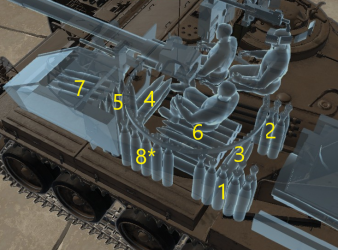
| Full ammo |
1st rack empty |
2nd rack empty |
3rd rack empty |
4th rack empty |
5th rack empty |
6th rack empty |
7th rack empty |
8th rack empty |
Visual discrepancy |
|---|---|---|---|---|---|---|---|---|---|
| 72 | 66 (+6) | 61 (+11) | 58 (+14) | 54 (+18) | 46 (+26) | 32 (+40) | 8 (+64) | 1 (+71) | No |
Notes:
- Shells are modeled individually and disappear after having been shot or loaded.
- Rack 8 is a first stage ammo rack. It totals 7 shells and gets filled first when loading up the tank.
- This rack is also emptied early: the rack depletion order at full capacity is: 8 - 1 - 2 - etc. until 7.
- Simply not firing when the gun is loaded will move ammo from racks 1 to 7 into rack 8. Firing will interrupt the restocking of the ready rack.
Machine guns
| 7.62 mm L3A1 | ||||
|---|---|---|---|---|
| Mount | Capacity (Belt) | Fire rate | Vertical | Horizontal |
| Coaxial | 3,000 (250) | 500 | N/A | N/A |
| Pintle | 2,000 (250) | 500 | -10°/+50° | ±180° |
Usage in battles
The Olifant Mk.1A is relegated to a support role as it lacks the armour to brawl or the mobility to flank. Players should get into a good position early in the game and use the powerful APFSDS shell of the Olifant to pick off hard targets.
Pros and cons
Pros:
- Strong and accurate APFSDS and HEATFS; similar ballistics to guns found on Rooikat MTTD and the Rooikat 105
- Laser rangefinder and NVD for long-range/night operations + bonus of smoke screen and smoke shells
- Excellent gun elevation and depression angles
- The machine gun area on the turret can bounce some carelessly aimed shells
- Fuel tanks in the front and rear may protect the engine, crew and the ammo racks from HEAT shells
- Acceleration is adequate once fully spaded; keeping similar instant mobility to the Centurion Mk 3 or Centurion Mk.5/1
Cons:
- Poor stock acceleration and top speed, compared to other MBTs at the BR; even inferior to the Chieftain Mk 5 when spaded
- APFSDS is a tier 4 modification: early module research must be done with the more unreliable HEAT shells
- Obsolete armour for the rank: unreliable against most APFSDS or HEAT rounds even with small calibre guns
- The ammo rack to the right of the driver is a major weak spot
- The engine roof is a weak spot for aircraft with large-calibre cannons
History
Predecessor: Olifant Mk.1
The Olifant Mk.1 was a South African conversion of Centurion Mk.3s tanks to a modified standard[1]. Conversions began in 1979 and lasted until 1984; a total of 153 Olifant Mk.1s were converted from Centurion Mk.3 tanks. Not long after the Olifant Mk.1 entered production, T-55 tanks were obtained and tested which revealed flaws in the Olifant Mk.1 by comparison. Fortunately for the SADF, an upgrade of the Olifant Mk.1 was already under development.
Olifant Mk.1A
The Olifant Mk.1A was an upgrade for the Olifant Mk.1 that began development in 1981. The main features were a new, fully stabilized 105 mm GT3B main gun, a new fire control system, and other improvements.
Design
General
The Olifant Mk.1A has a crew of four, the driver in the hull and the commander, gunner, and loader in the turret. It maintains the base of the Centurion but with overhauls in most important aspects such as mobility and firepower.
Mobility
The Horstmann suspension of the Centurion was retained on the Mk.1A, having never been changed on the Olifant Mk.1 or Mk.1A[1]. Propulsion was provided by a Continental 29-litre turbo charged air cooled V12 engine, which could produce 750 horsepower. In order to prevent the dust from the environment from interfering with the engine's operation, new dust filters were added. Additionally, a new rail system was implemented that allowed the engine to be replaced in only thirty minutes with a crane. A new transmission was fitted with two forward and one reverse gear. The Olifant Mk.1A had a horsepower to ton ratio of 13.39 hp/t and could achieve a maximum speed of 45 km/h.
The fuel supply was increased from 458 litres to 1,240 litres, allowing the range of the Olifant Mk.1A to increase to 350 km at the maximum (the Centurion Mk.5 could only travel 190 km maximum). The reliability and ease of maintenance took precedence on the Olifant Mk.1A, reducing the amount of maintenance that needed to be done overall.
Armament
The main armament of the Olifant Mk.1A was a 105 mm L7 or GT3B rifled cannon, which was fully stabilized. The ammunition initially consisted of the L52A3 APDS, M456 HEAT and M156 HEAT rounds. In the mid-1980s, M111 APFSDS rounds were acquired for use on the Olifant Mk.1A as the primary anti-tank ammunition. The ammunition stowage was redesigned and as such the total amount of 105 mm ammunition was increased from 64 to 72 rounds.
The turret rotation and gun elevation mechanisms were replaced with an improved electrical gun and turret drive, this allowed the turret drive to traverse the turret 360 degrees in 20 seconds[1]. Also, the main gun was fully stabilized. A new fire control system (FCS) was fitted. The gunner's 6x zoom sight was replaced with an Eloptro 8x zoom sight which included a laser rangefinder accurate to up to 10 km[1].
Secondary armament consisted of a coaxial 7.62 mm machine gun and a pintle-mounted 7.62 mm machine gun on the commander's cupola. At least 5,600 rounds of 7.62 mm ammunition were provided.
Protection
The Olifant Mk.1A retained the armour of the Centurion Mk 3. Needless to say, the Olifant Mk.1A was incredibly vulnerable to the T-54/55 and T-62 tanks it would face in combat, and also to RPG-7 infantry anti-tank weapons. The Olifant Mk.1A had two banks of four smoke grenades each mounted on each side of the turret for a total of eight launchers.
Production and Service
Production
The Olifant Mk.1A entered production in 1983 and entered service with the SADF in 1985. A total of 153 Olifant Mk.1As were converted from Olifant Mk.1s by the late 1980s and it was only adopted by South Africa.
Service
The first combat deployment of the Olifant Mk.1A was during the South African Border War which consisted of Operations Modular, Packer, and Hooper from 1987-1988. During these operations, South Africa came to the aid of the National Union for the Total Independence of Angola (UNITA) who were at risk of destruction by the People's Armed Forces of Liberation of Angola (FAPLA), who were supported by Cuba and the Soviet Union (USSR).
Eight brigades and an auxiliary support force of the FAPLA (along with Soviet advisors) moved from Cuito Cuanavale to attack the UNITA forces at Jamba and Mavinga. The SADF sent Olifant Mk.1 and Mk.1A tanks in two squadrons - of 11 tanks and two command tanks each - to Angola to reinforce the Ratel 90 armoured cars that made up the rest of the anti-armour materiel there. During the conflict, Olifants and Ratel 90s faced off against 150 FAPLA T-54 and T-55 main battle tanks (MBTs) in a large-scale conventional war fought at incredibly close ranges of only 50 to 150 m.
The Olifant Mk.1A saw its first combat with E-Squadron during Operation Modular in 1987. During that operation the tank crews preferred to load HEAT rounds rather than APFSDS rounds because HEAT rounds are effective against light and heavy armoured targets, though they could detonate prematurely upon contact with the brush. Additionally, HEAT rounds made a more noticeable visual indication of a hit on an enemy tank, and there was also a fear that APFSDS rounds would ricochet off of trees. Due to the thick brush, tank engagements occurred at very close ranges due to reduced visibility.
The first knock out of a FAPLA tank by an Olifant occurred during the Battle of Chambinga against the FAPLA 16th Brigade during Operation Modular, with a kill credited first to Lt. Hein Fourie's Olifant on 9 November 1987 followed by another credited to Lt. Abrie Strauss' Olifant.
The SADF began Operation Hooper on 2 January 1988, with F-Squadron under the command of Major Tim Rudman taking the offensive against the FAPLA 21st Brigade which was holding at the River Cuatir. During the operation, Cuban forces counterattacked in an action that resulted in the loss of several Olifant tanks; one was damaged in combat, two were detracked by anti-tank mines. The SADF mounted multiple attempts to recover the tanks but had to retreat under heavy attack by enemy guns and artillery. This left the amount of Olifants lost at three with one more damaged. Additionally, a Ratel armoured car was destroyed and four SADF soldiers were killed. The FAPLA lost 21 T-54/T-55 tanks and suffered 480 casualties.
The two detracked tanks were never moved while the third Olifant was taken by the FAPLA. Its turret was sent to the Soviet Union while the hull remains at Menongue Airport in Angola[1].
Devblog
Centurion tanks entered service with the South African armed forces already at the start of the Cold War in the early 1950s when South Africa purchased a few hundred Centurion Mk.3 tanks from the United Kingdom. However, operating the Centurions in the warm South African climate quickly turned out to be problematic as the tanks were prone to overheating. As a result, South Africa sold off many of its Centurions to Switzerland during the 1960s in order to acquire other equipment while many of the remaining tanks were relegated to reserve roles.
With conflicts in the region flaring up during the '70s, the South African armed forces were reminded of the importance of their armoured units and several projects were initiated to modernize the Centurions in service. These projects resulted in the creation of two interim models of domestic Centurions - the Skoikaan and Semel. In parallel however, the South African government formed a company in the private sector to develop a proper modernization package for the Centurion.
Work on the project began in the mid '70s, with South African engineers taking inspiration from the Israeli Sho't Centurions and applying similar upgrades to what would eventually become known as the Olifant tank. The first prototype of the Olifant rolled out of the factory in 1976 and underwent testing. Shortly afterwards, the Olifant Mk.1 entered production service in 1978, with production lasting until 1984. In the early 80s, the Olifant was upgraded to the Mk.1A modification, which featured a domestic version of the L7 cannon as well as other upgrades.
The Olifant Mk.1A remained in service with SANDF into the 1990s before being succeeded by the Olifant Mk.2. In total, over 150 Olifant Mk.1As were produced, some seeing action during the conflicts with Angola in the early 1980s.
Media
- Skins
- Images
See also
- Vehicles with similar chassis
- Related service history
- Similar playstyle
External links
References
| Britain medium tanks | |
|---|---|
| Valentine | Valentine I · Valentine IX · Valentine XI |
| Cromwell | Cromwell I · Cromwell V · Cromwell V (RP-3) |
| Cromwell derivatives | Challenger · Avenger · Comet I · Comet I "Iron Duke IV" · Charioteer Mk VII |
| Centurion | Centurion Mk 1 · Centurion Mk.2 · Centurion Mk 3 · Centurion Mk.5 AVRE · Centurion Mk 10 · Centurion Action X · FV4202 |
| Vickers MBT | Vickers Mk.1 · Vickers Mk.3 · Vickers Mk.7 |
| Chieftain | Chieftain Mk 3 · Chieftain Mk 5 · Chieftain Mk 10 |
| Challenger 1 | Challenger Mk.2 · Challenger Mk.3 · Challenger DS |
| Challenger 2 | Challenger 2 · Challenger 2 (2F) · Challenger 2 TES · Challenger 2 OES · Challenger 2E · Challenger 2 Black Night |
| Challenger 3 | Challenger 3 TD |
| Australia | A.C.I · A.C.IV · Centurion Mk.5/1 |
| South Africa | Olifant Mk.1A · Olifant Mk.2 · TTD |
| India | Vijayanta · Bhishma TWMP |
| Israel | ▄Sho't Kal Dalet |
| Jordan | Khalid |
| Sweden | ▄Strv 81 (RB 52) |
| USA | Grant I · Sherman II · Sherman Firefly · Sherman IC "Trzyniec" |


